Pablo de Laborde Lascaris interviewed by TETRAKTYSMAG
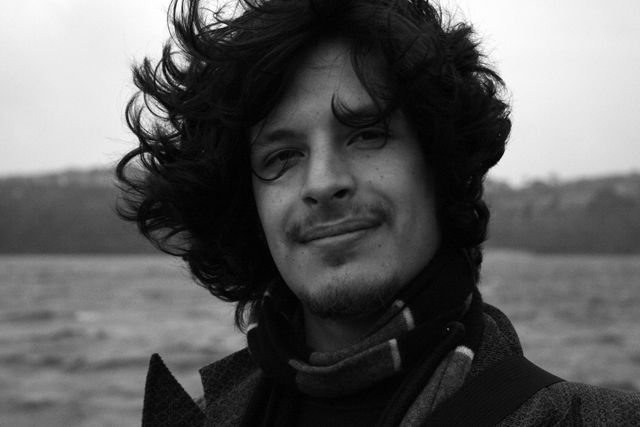
At the age of 28 and recently awarded with the IEAA (International Emerging Artist Award) 2013, Pablo de Laborde Lascaris certainly has something to tell us. Of Mexican origin but with roots from the Mediterranean basin - his father is from France and his mother from Greece, Pablo has the Mexican zest and intensity fused with the French elegance and the Greek pathos (meaning passion).
P+A: To begin, we would like to congratulate you for your success and wish you all the best.
Pablo: Thank you!
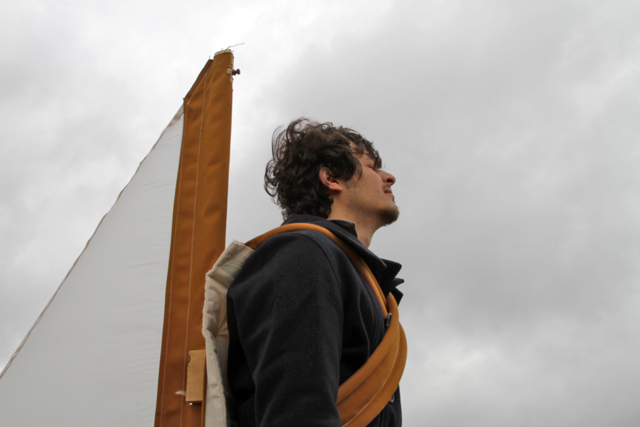
Anticipation, 2013, 45cm x 30cm, Digital Print, copyright Pablo de Laborde Lascaris
P+A: Could you provide some background information to our readers on how you got started?
Pablo: I suppose my interest in art started at an early age, in my mother’s sculpture studio in Mexico City, where I would play and start to develop techniques of working with materials such as wax, plaster, wood, and stone. My father shared this passion through his small collection of surrealist art. Both of these situations made it so I was fortunate enough to meet and engage with the artistic community of Mexico City, who supported and nourished my creative drive. Because of this I always took my art very seriously, which was possibly a mistake at such an early age. My attitude changed when I went to University, where I was able to turn ‘art’ into something more than just a nice object.
P+A: What is the best part of art making?
Pablo: The best part of making art is that I get to play all day! The process of altering and combining materials is vast and exciting. It can be very frustrating at times, as most of my ideas are unrealistic or impractical but the fun is trying to figure out how to compromise in order to produce a final piece. I often feel like an alchemist in a laboratory producing lots of bad ideas with a few golden specks hidden within.
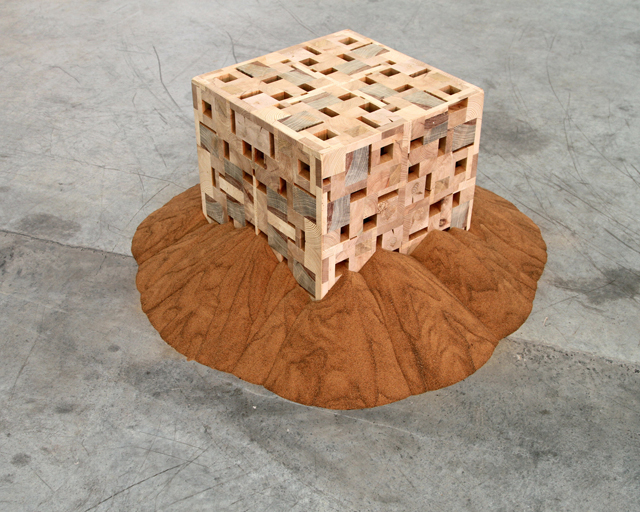
Ring to Grain, 2011, hard wood sculpture, copyright Pablo de Laborde Lascaris
P+A: Can you tell us a few things about your installation “Ring to Grain” which was the ticket to success for winning the IEAA 2013 award?
Pablo: I would not call it a ticket to success, it is an important piece but it does not define my practice! “Rings to Grain,” or “Cube,” was a defining point in my work, where a lot of things became clear and helped to establish the foundations of my current practice. “Cube,” is about the relationship between two materials combined to produce an object that is suggestive of time, movement, and displacement. The key quality of the piece is hidden within the creative process, indirectly building the negative space within the cube. The cube is filled with approximately 100kg of sand, which is released and allowed to pour out of the cube. It’s like a fountain of sand, only it’s motion is suggestive, not active. The cube itself is composed of different kinds of wood and built in such a way that one is able to see their end grain whose rings are indicative of a tree’s growth and age.
P+A: Are you always trying to pass a message through your artworks?
Pablo: I’m always trying to engage with people. I think I’m looking for an exchange or debate, rather than an answer. I think art should be about questions; art needs an element of uncertainty for both the artist and the viewer. The way I read into my work is as much affected by the viewer’s response as by my own interpretation. Once it’s finished it’s no longer within my control and I like that, it gives it a life of it’s own. I learn something new about my work every time I talk about it.
P+A: Are you afraid of success or is it something that you crave?
Pablo: I used to crave it! However success comes with a lot more responsibilities. I think I spend about 70% of my time on admin and 30% on the creative aspect, which is not what I signed up for when I chose to be an artist. On the other hand, success does open new doors that would have otherwise not been available, and it has made me more ambitious and determined to produce good work. I have actually taken a step back from competitions, as I need to spend more time making, rather than on admin.
P+A: With so many exhibitions up to now, do you think that life has been generous with you or is it the result of hard work?
Pablo: Hard work! The art world is not very generous; there are no favours, and it can be very disheartening. I think life has been generous to me but only because I asked, which takes a lot of determination and hard work. Determination is maybe the key word in there. My CV only contains my successes; if it featured my failures as well, it would be a much longer list! I have learned to crave an opportunity, rather than success.
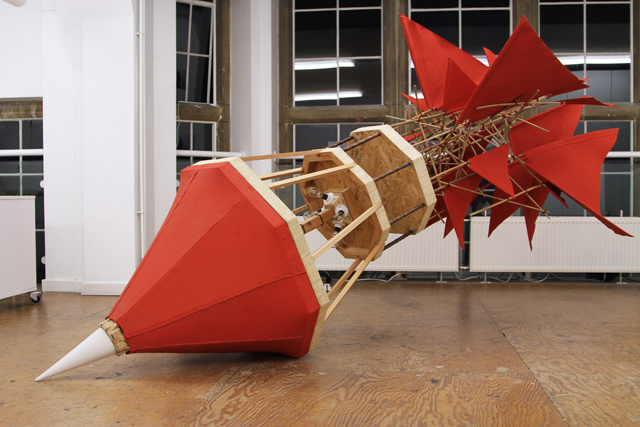
Starboard, 2013, 392cm x 176cm x 176cm, mixed media, copyright Pablo de Laborde Lascaris
P+A: What is the key element in creating a good composition?
Pablo: Stop thinking, shut yourself in an empty room, and stay there till you make something! Boredom leads to creativity, and playing is the “sketch” to a good composition.
P+A: From what are you motivated in order to make a work?
Pablo: Good question, and really hard to answer. I’m like a kid, if I’m not making something I get really restless. I start fidgeting and pacing so I guess I have to keep myself entertained. I’m focused when I’m producing work, and it’s so rewarding to see the development and completion of my labours. I also find motivation through the process of making something as you often get new ideas through making.
P+A: We read that your artistic approach is to “construct” a conversation between performance and sculpture. How would you describe your art?
Pablo: Though I do consider myself to be a sculptor, my approach to art goes beyond the sculptural form by converging with performance, installation, and video. I’m concerned with the static reputation of sculpture so I approach this topic by developing my work so that it’s either suggestive of motion, or is an interactive artefact in itself. The form and shape of a lot of my work is either mobile, illustrated through my video work, or is an installation, which in itself is variable and impermanent. I think about 80% of my work cannot exist without me being a part of either its construction or performance. I go where my work goes and I don’t think there’s a way around it.
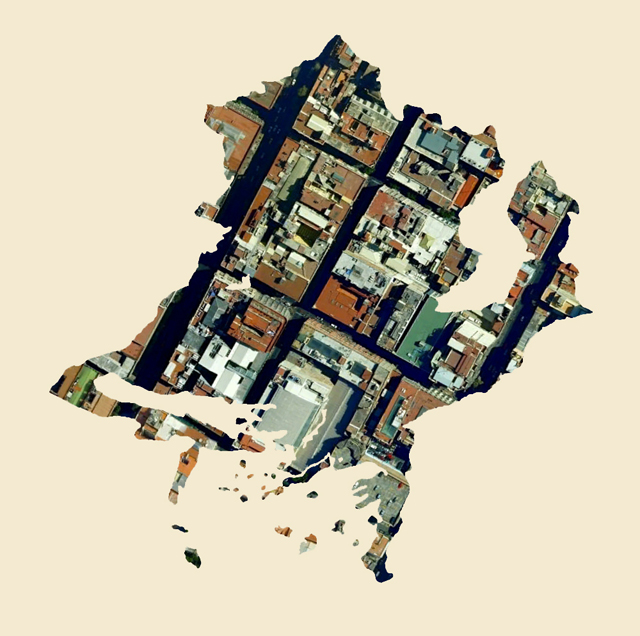
Pangaea Series no.5, 2012, 20cm x 20cm, Digital Print, copyright Pablo de Laborde Lascaris
P+A: In your Pangaea series (2012) you use aerial photos and maps of Mexico, Greece and France. Are those countries the entire earth (Pangaea derives from Greek words Pan meaning entire and Gaea meaning earth) for you and if so, why?
Pablo: I can see how you would interpret it as the “entire earth,” but the name refers more to the origin of earth, how it was physically before geographical and political divisions. Nationality is curious, because when you have more than one you’re never really sure of which one to choose. I often find myself hopping from one to the next, so I suppose the maps are like the puzzle in my head. Each map is a different variation, containing elements of each nation but resulting in combinations, which have an identity of their own. It’s a way of using nationalism against itself to produce something different and familiar at the same time. By removing the boundaries between one and the other, one is able to see the map as whole rather than it’s divisions. I suppose it’s the best way to describe my nationality, whose identification is different every day.
P+A: If you had a magic wand what would you change in the world?
Pablo: My tutor always asked me that. I’m not quite sure were to start. I studied sociology and anthropology so I’m going to approach this as a social experiment rather than a definite solution. If the world was a bowl of rice (with the people being the rice) I would scoop everyone up, give the bowl a good swirl and pour them back out. We are all much too comfortable where we are, and we are all too far apart, which can make us ignorant. We would lose some heritage and culture but would we gain a greater understanding of each other?
Ring to Rung, 2012, Video 1280 x 720, 2:38min, copyright Pablo de Laborde Lascaris
P+A: We saw that you are going to raise money from your upcoming exhibition to support the Muzanga Education Project. Do you think that lack of education should be an issue nowadays?
Pablo: Always. I think education is the key to all of our problems. I believe institutional education does need some serious restructuring, but a lack of education is where many of our problems originate, and through addressing this, they could be resolved. The charity I’m working with is raising money to provide a mobile school to reach remote villages in Zambia where the children would normally have no access to education. I met the founders of Raise a Smile Foundation in Berlin last year, and was struck by their determination and commitment to their project.
P+A: One final question for you. What are you reading in your spare time lately?
Pablo: I just finished reading ‘Six Fairy Tales from the Brothers Grimm illustrated by David Hockney.’ No particular connection to my work, but it’s a lovely book.
P+A: We would like to thank you for your time and we must say that it was a pleasure meeting you.
Pablo: Thank you for the opportunity!
Top image: Ring to Rung, 2012, still image, copyright Pablo de Laborde Lascaris
.png)



